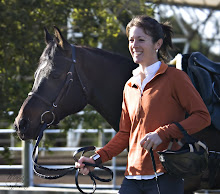Doing my best to minimize confusion, I gave her very clear instructions one at a time. But even the clearest instructions often won't help. In fact, I wondered if maybe we shouldn't bother with this any further. You see, the cruel reality is that no matter how skilled a rider becomes in administering these complex aids, there will always be something outside her realm-- perhaps a deer bounding out of the trees or a dog bolting from its hiding place of tall grass-- that will produce a better collected trot. Then, the single thing she will need to do is hang on to the reins in terror. Without needing to give any cues whatsoever, she will enjoy a few moments of brilliant collected trot and fancy prancing, exactly the stuff she struggles to create on her own.
These savory riding moments, while indeed scary and unpleasant, are what I like to call the Artificial Aids. If you can get past the upsetting fact that you have lost control of your horse--and that a tumble from the saddle might be imminent-- these moments can teach you what the magic of dressage should feel like. In one pure condensed instant, you will feel the incredible ways in which a horse can use his body. And you won't expend one drop of effort to accomplish it. His neck will arch proudly, his back muscles will swell under you, his body will tone itself like a fighter, and he will bound across the arena with brawn and grace.
I became acquainted with the Artificial Aids early in my riding career. To be specific, I was a crying, petrified 9-year old the first time I felt a truly collected trot. And I never wanted to feel it again. Never mind that my mother had been trying to teach me about half-halts and collection for months to no avail. Mounted on my mother's F.E.I. Warmblood, I found myself in an airborne gait, due to a herd of deer that sprang from the woods on a fresh spring morning. We lurched and catapulted across the field, my spine whipping back and forth like a branch in wind. I held my breath and hoped for it to be over soon, whatever is WAS that we were doing. Through the wind rushing pat my ear, I heard my mother gushing praise. "Yes, that's great!" she called out. "That's an excellent collected trot, keep at it!"
How could anything be good about this?
I write with certainty that most of you know what I am referring to. Most students have experienced an unsolicited piaffe or passage due to a loose dog, a rattling El Camino, a horse running in a nearby field, or other prompts from nature. Unfortunately, most students fixate on the scary unpleasantness of these situations. But when I am working with riders like my student last week, I encourage them to embrace the next airborne spook with an open mind and a butt glued in the saddle. Try to let its affect counter-balance the hours of struggling to execute a proper half-halt that might finally tuck your horse's hindquarters under him and ride this one for free!
My former competitive trail mare, Charlotte, gave me a lot of chances to practice this idea. Given that she logged so many training miles, Charlotte rarely spent the energy to give things a second look, much less spook at them. Hereford cows were the exception. All other kinds of cows were fine, but for some reason Herefords sent the mare into a state of electricity. One moment we would be trotting rhythmically down a gravel road and the next we looked like an audition for the Royal Lipizzaner Stallion performers. Charlotte and I covered hundreds and hundreds of miles together both training and competing in distance events, and eventually I knew every hillside in Vermont or New Hampshire occupied by a Hereford. By that time, I quit leaning forward into a fetal position while clamping on to the reins and yelling at her to stop acting like a bonehead. Instead, I sat down in the saddle, lifted my chin, and rode the finest collected trot that mare could do. My mother, meanwhile, beamed with pride beside us on her unflappable Morgan as if to say "See? Do you finally feel what I've been trying to teach you?"As I write this, signs of spring surround me: birds sing in the trees overhead, frisky barn cats roll around in the driveway, Harley motorcycle riders rev past the barn in shirt sleeves. These are all preludes to the great activity of warm evenings ahead-- bolting dogs, quail scuffling in shrubs, jumping deer. Consider this your warning to be ready. Sit down, look up, and take the next chance to stop cussing and start riding some unearned prancing!




